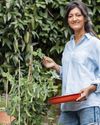
The sun is high in the sky, you can garden almost until bedtime and there's simply no better place in the world to be right now than your vegetable patch. You can almost taste the anticipation, with all those crops that you sowed in the springtime just beginning to deliver and the first harvests of the season arriving in the kitchen at last. As the gardening year really moves into top gear, though, your monthly spend at the garden centre can soar if you're not extra careful - especially these days, when prices everywhere seem to be rising fast. But there's no need to do without.
This month, we'll be showing you how to expand your veg growing with new raised beds and containers - but at a fraction of the cost to your purse and the planet, compared to buying materials brand new.
Repurposing and upcycling old, unwanted materials helps to keep your garden's carbon footprint as low as possible, and you get a new vegetable patch with hardly a dent in your bank balance.
Ready to pick
You know summer has truly begun when you sit down to your first plateful of buttery new potatoes and sweet baby broad beans from the garden. June harvests, grown fast and eaten young, are among the most delicious of the year.
Gradually start digging up your new potatoes from about ten weeks after planting. They'll usually be flowering at this point; as the flowers fade on the remaining plants over the next few weeks, the harvests get bigger. You can test the size of tubers by burrowing alongside plants with your fingers. Broad beans are ready when you can feel beans swelling inside the pods.
Pull beetroot no bigger than table tennis balls, and snip baby-leaf lettuces and annual herbs at 10cm. You can steal extras, too: snip curly pea shoots and beetroot leaves for salads and pinch out broad bean tips to wilt in butter for an unusual side dish.
This story is from the {{IssueName}} edition of {{MagazineName}}.
Start your 7-day Magzter GOLD free trial to access thousands of curated premium stories, and 9,000+ magazines and newspapers.
Already a subscriber ? Sign In
This story is from the {{IssueName}} edition of {{MagazineName}}.
Start your 7-day Magzter GOLD free trial to access thousands of curated premium stories, and 9,000+ magazines and newspapers.
Already a subscriber? Sign In

A new plot for tasty crops
Taking on a new allotment needn't be hard work. By simply following a few easy tips you can have bumper crops in no time, just like Alessandro Vitale

We love July
July is an island floating between the joy of June and the slightly fatigued month of August. It's a grown-up month: the year has shrugged off its adolescent exuberances, the weather is (hopefully) warm enough for ice cream to be one of your five a day, the sea should be swimmable without (too much) danger of hypothermia and thoughts will be of holiday shenanigans and family barbecues. School's out this month, the next tranche of glorious summer colour is washing across our borders and it's my birthday. Lots of reasons to give three rousing cheers for July!

YOUR PRUNING MONTH
Now, at the height of summer, Frances Tophill shows how to boost your plants' health and productivity with a timely cut

Hassle-free harvests
Flowers are out in abundance this month and for Jack Wallington, many of these blooms make delicious, low-effort pickings

Bite-sized bounties
Glorious doorstep harvests can easily turn into gluts, so let Rukmini Iyer's recipes help you savour every last bit

Upcycled outdoor living
Create unique and stylish garden features for minimal cost using reclaimed materials and simple DIY skills. Helen Riches shares four step-by-step projects and more inspiring eco tips

Secrets of a COLOURFUL GARDEN
Buildings and landscapes can play a vital role in supercharging your space, as Nick Bailey demonstrates

Greening up a city balcony
Looking for sustainable, small-space gardening ideas? Take inspiration from Oliver Hymans' transformed balcony garden in north-east London - now a lush, green haven for humans and wildlife

The dry and mighty garden
As we adapt our gardens to a more volatile climate, Alan Titchmarsh reveals how to create a drought-tolerant plot and picks his top plant performers

Nature knows best
Carol Klein explains how to choose plants for specific growing conditions, based on what has naturally adapted to thrive there